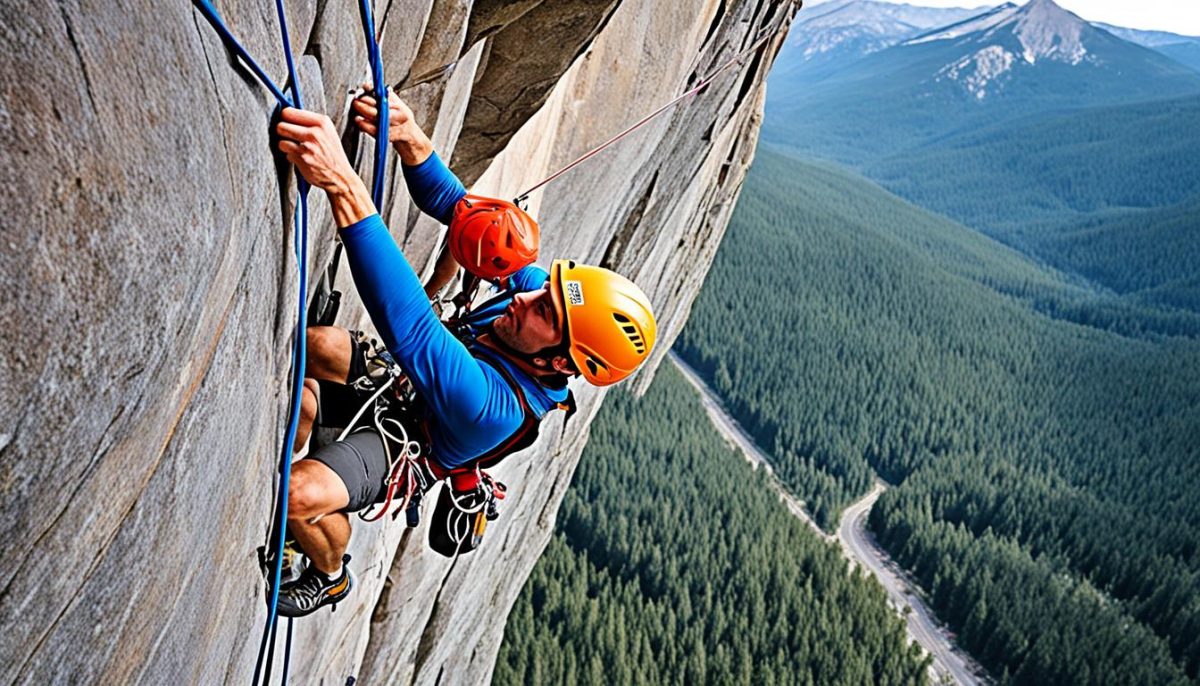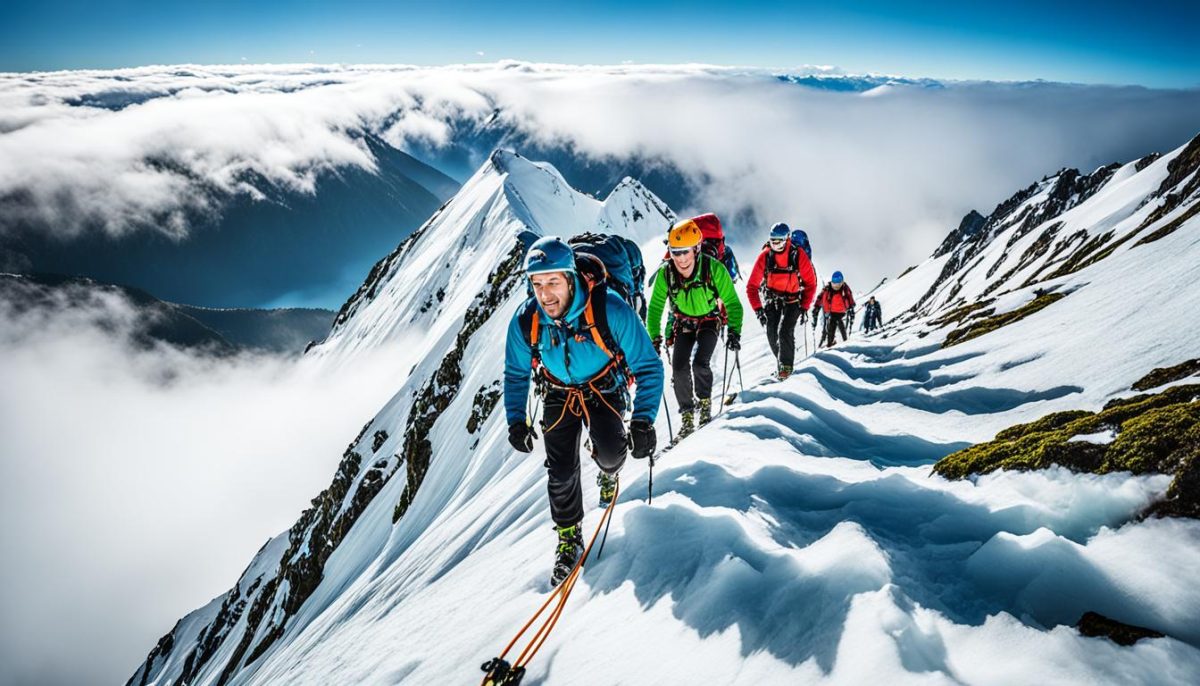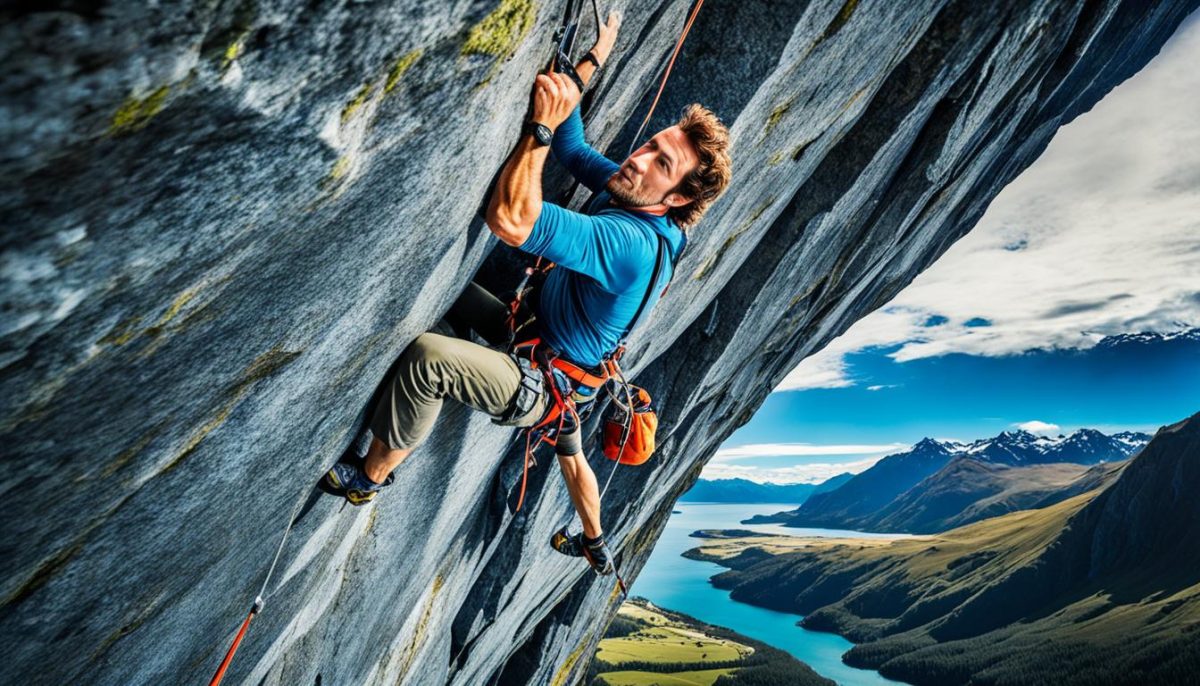Welcome to the thrilling world of lead climbing, a fascinating form of rock climbing that challenges both your physical strength and mental focus. Whether you’re a seasoned climber looking to try something new or a beginner eager to take your climbing skills to new heights, lead climbing offers an exhilarating adventure. In this section, we will explore the basics of lead climbing, including the necessary techniques, equipment, and skills required for this exciting sport.
Lead climbing involves ascending a route from the bottom up while attaching your own protection devices and ropes to secure yourself. Unlike top rope climbing where the rope is already in place, lead climbing requires you to place protection devices such as quickdraws along the route and clip your rope into them as you climb. This technique allows you to experience the true essence of rock climbing, as you face the challenges and conquer the obstacles of the route head-on.
Whether you’re scaling the towering cliffs of Yosemite National Park or exploring the rugged limestone formations of Kalymnos Island, lead climbing opens up a world of possibilities for exploration and adventure. It requires a combination of physical strength, technical skill, and mental agility to navigate the wall, making it a rewarding experience for climbers of all levels.
In the upcoming sections, we will delve deeper into the intricacies of lead climbing. We will discuss the specific techniques involved, the essential equipment needed, the skills and training required, as well as the vital safety measures to ensure an enjoyable and secure climbing experience. So, gear up and get ready to embark on an incredible journey into the world of lead climbing!
The Technique of Lead Climbing
Lead climbing is a dynamic and exhilarating form of rock climbing that requires specific techniques to ensure safety and success. In this section, we will explore the essential aspects of lead climbing technique, including clipping, route reading, and fall factors.
Clipping into Protection Devices
One of the fundamental skills in lead climbing is the ability to efficiently clip into protection devices such as quickdraws. Quickdraws are specialized equipment consisting of two carabiners connected by a nylon sling. When climbing, you must clip the rope through the carabiners to secure yourself to the quickdraws.
Proper clipping technique involves using one hand to hold the rope below the quickdraw and smoothly feeding the rope through the carabiners with the other hand. This technique ensures a secure connection while minimizing rope drag, which can hinder upward progress.
Mastering the Art of Route Reading
Route reading is the skill of visually analyzing a climbing route to determine the most efficient path up the wall. A thorough understanding of the route’s features, such as holds, cracks, and footholds, is crucial for planning and executing successful climbs.
When route reading, climbers assess the difficulty of each section, plan specific movements, and anticipate potential challenges. By mentally rehearsing the sequence of moves, climbers can optimize their climbing strategy and conserve energy for more challenging sections.
Understanding Fall Factors and Safe Fall Management
Fall factors refer to the potential severity of a fall in lead climbing. Factors such as the distance fallen, the amount of rope in the system, and the effectiveness of the climber’s protection contribute to fall forces and the risk of injury.
Managing falls safely is a crucial aspect of lead climbing technique. Climbers must be prepared to react quickly and appropriately in the event of a fall, including maintaining a safe distance from the wall, correctly positioning the body to avoid obstacles, and communicating with the belayer to ensure a controlled descent.
| Clipping | Route Reading | Fall Factors |
|---|---|---|
| Master the art of efficiently clipping into quickdraws. | Develop the skill of analyzing climbing routes for efficient ascent. | Understand the factors that contribute to fall severity. |
| Ensure secure connections while minimizing rope drag. | Anticipate challenges and plan specific movements. | React quickly and appropriately to manage falls safely. |
To illustrate these lead climbing techniques, let’s take a look at a climber in action:
“Lead climbing requires a blend of physical strength, mental focus, and precise technique. Mastering the art of clipping, route reading, and fall factor management is essential for a successful and enjoyable lead climbing experience.”
By honing these lead climbing techniques, climbers can enhance their overall climbing abilities and confidently tackle more challenging routes. In the next section, we will delve into the essential equipment required for lead climbing.
Essential Equipment for Lead Climbing
When it comes to lead climbing, having the right equipment is crucial for a safe and successful ascent. In this section, we will explore the essential gear you’ll need to conquer the vertical challenges that await you.
Lead Rope
The lead rope is your lifeline in lead climbing. It is specially designed to bear the weight of a falling climber and should be dynamic to absorb the impact of a fall. Look for a lead rope that is certified and has a diameter suitable for your climbing style and preferences. Keep in mind that a longer rope allows for more flexibility in choosing routes.
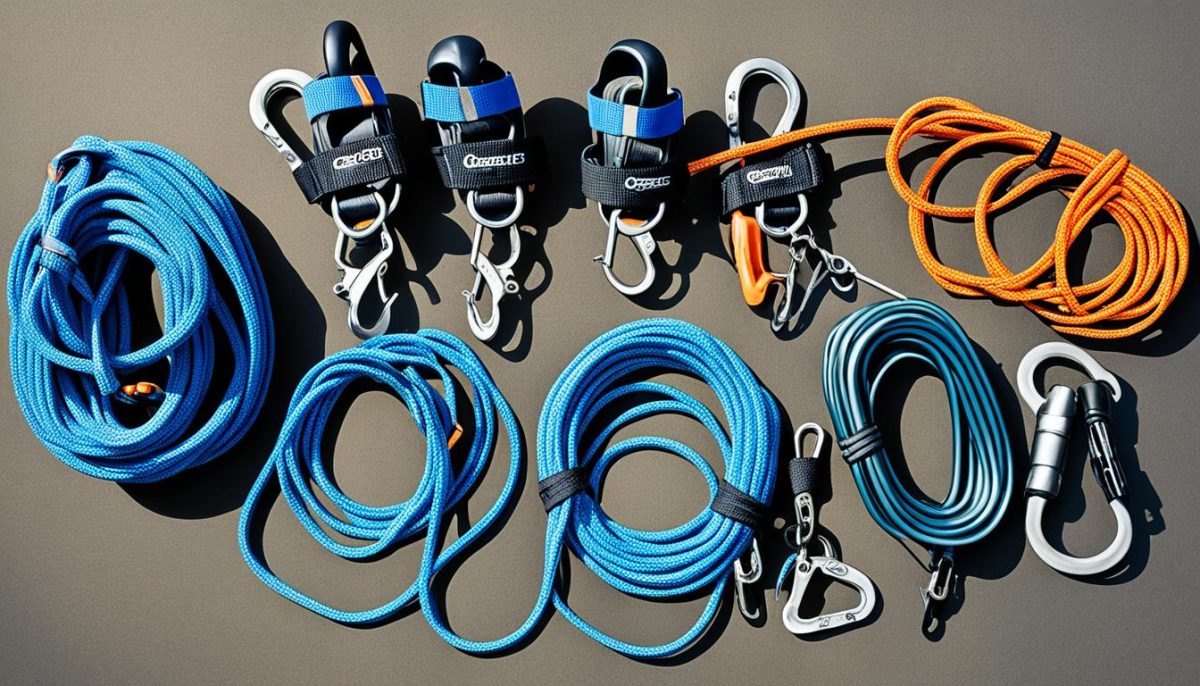
Quickdraws
Quickdraws are an essential part of the lead climber’s arsenal. These specialized devices consist of two carabiners connected by a sling. Quickdraws are used to connect your rope to the protection devices, such as bolts or cams, as you progress up the wall. Make sure to choose quickdraws that are lightweight, durable, and easy to handle.
Harness
Your harness is an integral part of your lead climbing gear. It serves as the link between your body and the rope, distributing your weight and providing a secure attachment point. Look for a harness that fits well and offers ample padding and adjustability for comfort during long climbs. It’s also important to ensure that your harness has a belay loop for tying in and attaching quickdraws.
Additional Safety Gear
In addition to the lead rope, quickdraws, and harness, there are a few additional pieces of safety gear that every lead climber should consider. Carabiners are essential for connecting various components of your gear, while helmets provide protection from falling debris. Remember, safety should always be a priority in lead climbing, so investing in high-quality gear is of utmost importance.
Now that you’re familiar with the essential equipment for lead climbing, you can confidently gear up and embark on your climbing adventures. Remember to always inspect your gear before each climb and replace any worn or damaged equipment. Stay safe, have fun, and enjoy the exhilarating experience of lead climbing!
Skills and Training for Lead Climbing
Developing the necessary skills and training is essential to excel in lead climbing. It requires a combination of physical strength, mental focus, and technical proficiency. In this section, we will explore various aspects of skill development and training for lead climbing.
Strength Training
Building strength is crucial for successful lead climbing. Incorporating exercises that target key muscle groups can help improve endurance and power. Some effective strength training exercises for lead climbing include:
- Hangboard training to strengthen finger and forearm muscles
- Campus board exercises to improve upper body strength and coordination
- Core workouts to enhance stability and balance on the wall
Integrating these exercises into your training routine can significantly improve your lead climbing abilities.
Mental Focus
Alongside physical strength, mental focus plays a vital role in lead climbing. It is essential to develop mental strategies to overcome challenges, manage fear, and maintain concentration on the wall. Some techniques to enhance mental focus in lead climbing include:
- Visualization exercises to mentally rehearse climbing sequences and overcome obstacles
- Breathing techniques to calm the mind and maintain composure during challenging sections
- Positive self-talk to boost confidence and stay motivated
By training your mind to stay focused and positive, you can overcome mental barriers and perform better in lead climbing.
Technique Practice
Efficient climbing technique is crucial for conserving energy and making progress on difficult routes. Devoting time to technique practice can greatly enhance your lead climbing skills. Some techniques to focus on include:
- Balancing and weight shifting to maintain stability and control
- Precise footwork to find the best holds and create efficient movement
- Body positioning to optimize reach and minimize strain
Regularly practicing these techniques on both indoor and outdoor climbing walls can help refine your movement and improve overall performance.
Remember to prioritize safety while practicing and developing your lead climbing skills. It is crucial to seek guidance from experienced climbers or hire a qualified instructor to ensure proper training techniques and minimize the risk of injury.
Safety Measures in Lead Climbing
Lead climbing is an exhilarating sport that offers a unique challenge and sense of accomplishment. However, it is crucial to prioritize safety at all times to ensure a positive and secure climbing experience. By implementing proper safety measures, climbers can mitigate risks and enjoy the sport to its fullest. In this section, we will explore key safety protocols in lead climbing, including risk management, partner communication, and anchor building techniques.
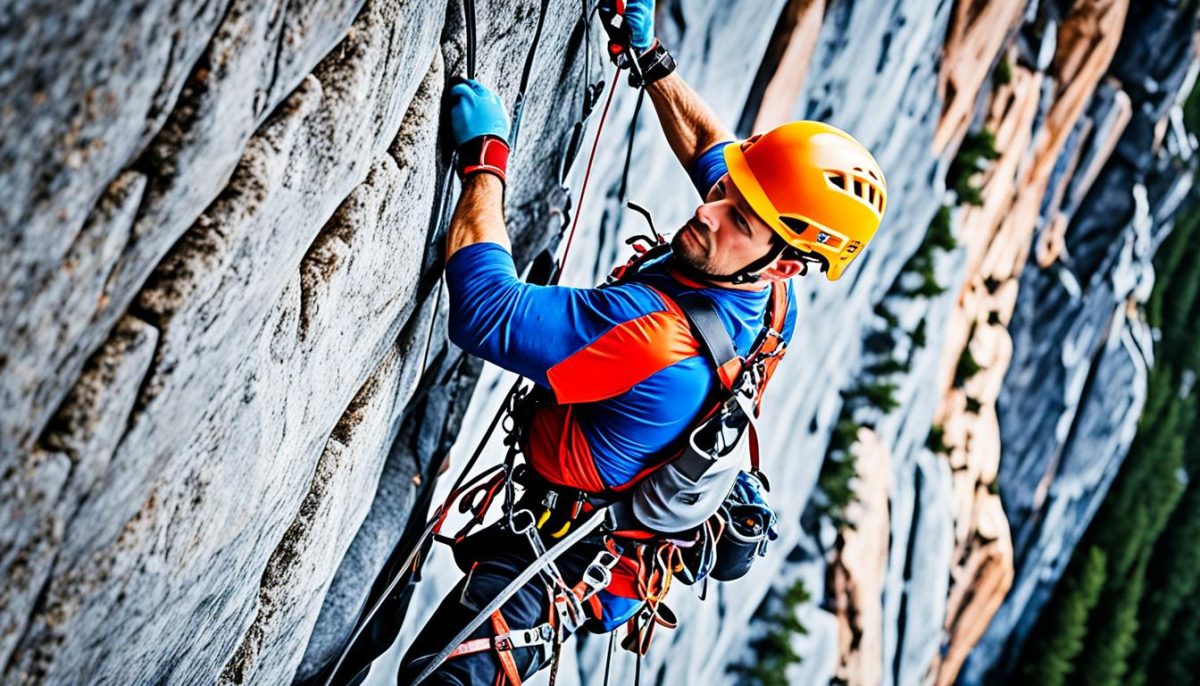
Risk Management
Effective risk management is essential in lead climbing to minimize the chances of accidents and injuries. Before starting a climb, it is crucial to thoroughly assess the route’s difficulty, potential hazards, and personal capabilities. Climbers should consider factors such as weather conditions, route conditions, and their own physical and mental readiness. By making informed decisions and recognizing potential risks, climbers can significantly enhance their safety.
Partner Communication
Clear and efficient communication with your climbing partner is vital in lead climbing. Prior to starting a climb, establish a system for communicating key information, such as signals for rope tension, potential hazards, and route guidance. Effective communication ensures that both climbers are aware of each other’s actions and intentions, reducing the likelihood of accidents or misunderstandings.
Remember, communication is not only about talking but also actively listening. Establish trust with your climbing partner and create an open dialogue to foster a safe and collaborative climbing environment.
Anchor Building Techniques
Building secure anchors is crucial for the safety of lead climbers. Properly constructed anchors provide the foundation for a reliable climbing system and ensure that falls are safely caught. It is crucial to learn and practice anchor building techniques under the guidance of experienced climbers or instructors. Familiarize yourself with different types of anchors, including traditional gear placements and bolted anchors, and understand how to assess their integrity. Investing time in mastering anchor building skills will greatly enhance your safety in lead climbing.
Advancing in Lead Climbing
As you gain experience and confidence in lead climbing, it’s natural to seek new challenges and opportunities to continue progressing in this exciting sport. Advancing in lead climbing involves pushing your limits, honing your skills, and expanding your climbing horizons. Here are some key steps you can take to advance in lead climbing:
1. Seek out Challenging Routes
One of the best ways to improve your lead climbing abilities is to tackle more challenging routes. Look for climbs that push your physical and mental limits, requiring technical skills, strength, and problem-solving. As you push yourself on difficult routes, you’ll learn new techniques and develop a deeper understanding of climbing movement.
2. Explore Outdoor Climbing Destinations
Outdoor climbing offers a different experience compared to climbing in a gym. Outdoor environments present unique challenges such as varied terrain, different rock types, and unpredictable weather conditions. By exploring different outdoor climbing destinations, you’ll gain valuable experience and adaptability in handling different climbing scenarios.
“Outdoor climbing allows you to immerse yourself in nature’s beauty while challenging yourself on real rock. Each climbing area offers a unique experience, from the towering granite walls of Yosemite to the exposed limestone cliffs of Kalymnos. The world is your climbing playground.”
3. Seek Guidance from Experienced Climbers and Instructors
Learning from experienced climbers and instructors can greatly accelerate your progress in lead climbing. Seek out mentorship and guidance from those who have mastered the craft and can offer insights, tips, and techniques to help you overcome challenges and refine your skills. Their knowledge and experience will prove invaluable in your journey to becoming a better lead climber.
4. Continuously Learn and Grow
Lead climbing is a lifelong learning process. Stay curious and open-minded about new techniques, gear advancements, and safety practices. Attend workshops, clinics, and training camps to expand your knowledge base and refine your skills. Embrace a growth mindset and approach each climb with a commitment to learning and improvement.
By embracing these steps, you can challenge yourself, broaden your climbing horizons, and continue advancing in lead climbing. Remember, the joy of lead climbing comes not just from reaching the top but from the journey of growth and pushing past your limits.
Image: A climber ascending a challenging route, displaying advanced lead climbing techniques
Competitions and Events in Lead Climbing
In the exhilarating world of lead climbing, there is a vibrant community that comes together to celebrate the sport and showcase their skills. Lead climbing competitions, climbing festivals, and community events offer climbers the opportunity to connect with fellow enthusiasts, push their limits, and immerse themselves in the thrill of the sport.
Lead climbing competitions are high-energy events that bring together top climbers from around the world to compete on challenging routes. These competitions test not only their physical abilities but also their mental strategy, endurance, and ability to perform under pressure. Climbers showcase their technical prowess, speed, and agility as they navigate difficult routes and strive to achieve new heights.
Climbing festivals are gatherings that celebrate the sport of lead climbing and the sense of community it fosters. These events often feature workshops, clinics, and demonstrations led by experienced climbers, allowing participants to learn new techniques, improve their skills, and gain valuable insights from industry professionals. Climbers of all levels come together to share their passion, connect with like-minded individuals, and form lasting friendships.
Community events play a crucial role in fostering a sense of belonging and camaraderie among lead climbers. These events range from casual bouldering sessions at local gyms to outdoor climbing outings organized by climbing clubs. They provide an opportunity for climbers to network, share experiences, and learn from one another, creating a supportive and inclusive environment for everyone to thrive.
Whether you’re an experienced climber looking to compete at the highest level or a beginner seeking to immerse yourself in the vibrant lead climbing community, participating in lead climbing competitions, climbing festivals, and community events can be a transformative experience. It’s a chance to push your limits, forge new friendships, and celebrate the incredible sport of lead climbing.
Upcoming Lead Climbing Events:
| Event | Date | Location |
|---|---|---|
| World Lead Climbing Championship | August 15-18, 2022 | Paris, France |
| Mountainfest Climbing Festival | September 2-5, 2022 | North Conway, New Hampshire, USA |
| Local Climbing Club Meetup | Every Saturday | Your local climbing gym or outdoor crag |
Tips for Success in Lead Climbing
Successfully navigating the world of lead climbing requires more than just physical strength and technical skills. Mental strategies play a crucial role in overcoming fears and challenges on the wall. To excel in lead climbing, it’s essential to develop a resilient mindset and employ effective mental strategies.
One valuable mental strategy is route visualization. Before even setting foot on the climbing route, take a moment to visualize yourself climbing it successfully. Imagine each move, anticipate potential challenges, and strategize the best sequences. By mentally rehearsing the route, you’ll feel more prepared and confident when tackling it in reality.
While self-motivation is important, seeking mentorship and guidance from experienced climbers can greatly accelerate your progress. Mentors can provide valuable insights, offer personalized feedback, and share their own experiences and tips for success. Don’t hesitate to reach out to climbers you admire or join a mentorship program to fuel your growth as a lead climber.
Remember, lead climbing is a journey. It’s normal to face setbacks and encounter routes that push your limits. However, with the right mindset, consistent practice, and the support of mentors and the climbing community, you can conquer new heights and achieve your lead climbing goals.

